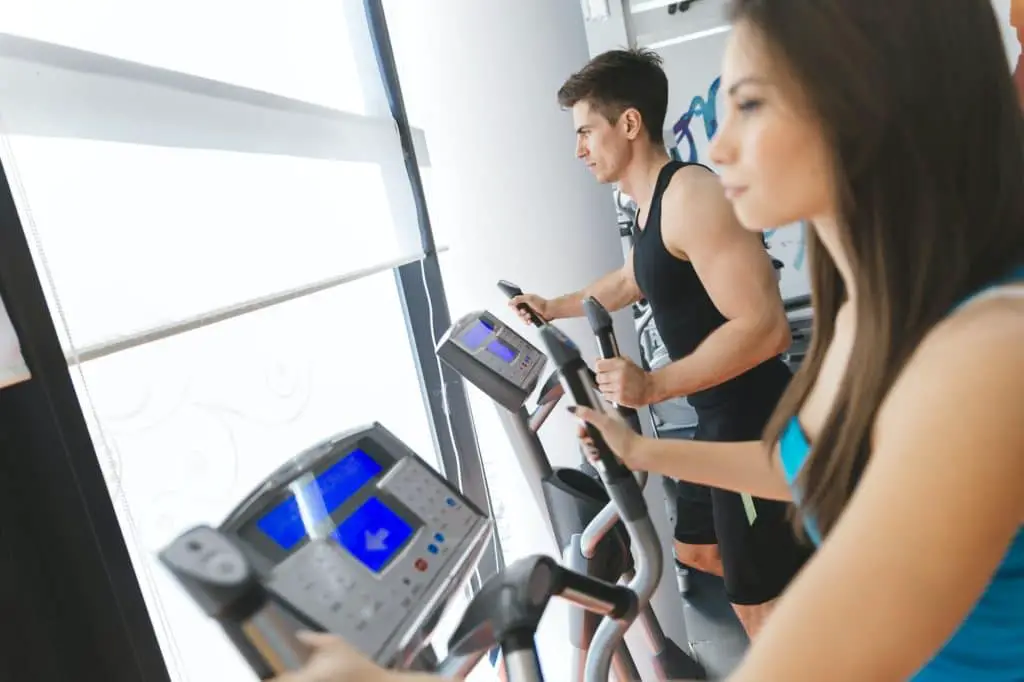Do you ever feel like it is time to increase your fitness, but you do not know which form of exercise is the most effective for reaching your goals? A gym has a wide range of options when it comes to workout equipment, such as elliptical trainers, but many gyms are also expensive, making it tempting to run outside for free instead. The main difference between running and elliptical is the level of impact.
Running is better if you want to burn more calories and build more muscle with shorter time. Elliptical is better if you have injuries and your joints cannot tolerate the high impact of running.
In this article, we will discuss the advantages and disadvantages of running and using an elliptical trainer, the accuracy of elliptical miles, how to convert distances on an elliptical, which settings are closest to running and whether or not an elliptical will improve your running.
Does elliptical burn fat faster than treadmill?
The elliptical and the treadmill are both effective machines that can help you get a great cardiovascular workout. However, they are also useful for people with low back and muscle pain. Using an elliptical machine for low-impact activity is not recommended if you’re not sure about its proper use. However, it can be beneficial for people with arthritis to use it instead of running or jogging.
While jogging on a treadmill, an individual burns about 705 to 866 calories. According to a study, one hour of exercise on an elliptical machine will burn about 773 calories. A 200-pound person will burn approximately 1,032 calories in an hour while using an elliptical machine. A heavier person will burn 1,000 calories in less than an hour.
A half-hour on an elliptical five days a week will help you lose 500 calories from your diet. It will also give you a boost to lose 2 pounds in a week. A short 15 minute elliptical exercise can help improve your overall health. It can also help you reach a higher intensity if used properly.
Benefits and Downsides of Running and an Elliptical
Pros of an elliptical:
- It is low impact, putting less strain on your joints—helpful for people with injuries or knee, hip or lower back pain, especially arthritis.
- You can work your arms and upper body at the same time by using the moving hand bars.
- You can go backward to strengthen other muscle groups, such as your hamstrings, glutes and calves.
Cons of an elliptical:
- It does not promote as much muscle development.
- It might burn fewer calories—although it depends on how much effort you are expending and how high you set the resistance.
- It could become boring more quickly than running outside.
Running pros:
- You get to be in nature.
- It is less expensive—you do not have to pay for a gym membership or buy an elliptical for your home.
- It builds more stamina and agility.
Running cons:
- It is very high impact—and if you have a body mass index that is greater than 25, you are even more prone to injuries.
Related: How does shoe drop affect running?
Cardio benefits are fairly similar between running on an elliptical and running outside, according to a study by the University of Wisconsin-La Cross. For a faster comparison between using an elliptical and running based on six major factors of a workout, check out the table below.
| Elliptical | Running | |
| Cardio | Equal | Equal |
| Impact | Lower – reduces risk of injury | Higher – greatly increases risk of injury |
| Socialization | Typically less social and can be more boring | Many people run in groups or with a friend, making it more social |
| Expense | Expensive unless you live in an apartment complex that includes a free gym | Free |
| Strength | Produces a little less muscle development | Produces a high level of muscle development |
| Calorie Burn | Usually burns fewer calories unless you are exerting maximum effort at a high level of resistance | Usually burns a greater amount of calories |
If You Want to Tone Your Buttocks
The elliptical works various muscle groups in the upper and lower body. These include the glutes, hamstrings, and the tensor fascia latae. An elliptical training session activates various muscles in the upper and lower bodies. These include the glutes, the tensor fascia latae, the hamstrings, and the calves.
You’ll burn more calories running than using an elliptical machine. However, it’s a small edge compared to the machine’s total calorie-burning capabilities. An elliptical is a low-impact cardio tool that can help tone and tighten your glutes. It’s also a great way to get in shape without being limited by your body’s natural resistance.
Related: Can Walking Tone Your Bum? (No, Do These Instead)
Average Mile Time on an Elliptical

If you are wondering how long a mile on the elliptical is, the typical amount of time it takes to run a mile on an elliptical trainer is 8–10 minutes.
This depends on how fast you usually run and the level of resistance you like to use, as everyone’s running pace is different. If you typically run faster, your time will be shorter. If you like to use more resistance, your time might be longer.
Accuracy of Miles on an Elliptical
According to ABC News, the distances of elliptical miles are likely to be fairly accurate, but the calories an elliptical projects that you burn could be up to 20 percent different in reality. The calorie burn feature is based on generalizations about your age, weight, speed and energy expenditure that are not necessarily true for every individual, resulting in possibly a lower calorie burn than what you read on the screen.
Even though it might feel like you are running less on an elliptical than what it reads, part of the reason you feel like you are exerting less effort is that you have less resistance because your legs are being pulled back automatically instead of you bearing all of your body weight on your own.
Plus, if you live in a location with warm weather, the temperature can make a large difference in your level of exhaustion. Wind resistance, inclines and elevation can all make running outside feel more difficult as well.
However, if your stride length is considerably longer or shorter than the average, it could cause a bit of variation between the projected miles and the actual distance. A typical stride length on an elliptical trainer is between 14 and 22 inches, which is shorter than a typical running stride outdoors.
Converting Distances Between an Elliptical and Running Outside
Because the distance is usually inaccurate on an elliptical trainer, you can convert the distance yourself by measuring the distance between the forward-most point of your stride and the furthest point behind you that your foot can reach. This will give you the stride length of the elliptical.
You can then calculate a mile on the elliptical by dividing the stride length of your elliptical trainer by the number of inches in a mile, which is 63,360. For instance, you would travel a mile in 3,168 strides on an elliptical trainer with a stride length of 20 inches. For how many RPMs it takes to go a mile, divide this number in half—1,584 RPMs in this example. See the table below for more conversions.
| Stride Length | Number of Strides | RPMs |
| 14 | 4,526 | 2,263 |
| 15 | 4,224 | 2,112 |
| 16 | 3,960 | 1,980 |
| 17 | 3,727 | 1,864 |
| 18 | 3,520 | 1,760 |
| 19 | 3,335 | 1,668 |
| 20 | 3,168 | 1,584 |
| 21 | 3,017 | 1,509 |
| 22 | 2,880 | 1,440 |
For a conversion between strides and steps, multiply the number of minutes you work out at a moderate pace by 203. Thus, running on an elliptical trainer for 30 minutes is approximately 6,090 steps.
For a third way to measure the distance, you can convert the stride length of your elliptical into feet and divide it by 5,280 (the number of feet in one mile). That will give you the rough number of revolutions it takes to travel a mile on an elliptical trainer.
To calculate the distance traveled by an elliptical, divide the total strides by the 20-inch stride length. Getting on the elliptical every morning is not ideal for your body. According to the American Council of Exercise, you should rest for at least one day after each exercise session.
Elliptical Settings to Mimic Running
To mimic running outside on an elliptical trainer, use inclines and resistance.
Because everyone has a different typical running workout depending on where they live and how far they run, the settings that most closely mimic your run depends on you. If you live in an area with a lot of hills, use a high incline.
Tip: If you run on a track or in a flat neighborhood, stick with a low resistance. For a good mixture of both terrains, try an interval workout at 90 RPM that alternates between a medium incline and a high incline.
The duration also depends on your running habits and goals. If you are training for a 5K or a 10K, shorter interval workouts more frequently throughout the week are more effective. If you are preparing for a marathon, complete longer workouts at an easier to moderate level of difficulty.
Does Work Out on an Elliptical Improve Running?
Some of the data an elliptical provides can be useful for improving running. For instance, most ellipticals have a cadence meter. Professionals suggest a fast cadence and short strides to avoid injury while running—ideally around 180 strides per minute, which translates to 90 rotations per minute (RPM) on an elliptical. Using an elliptical to help you adhere to this pace and grow accustomed to it can be helpful for your outdoor running.
Related: How Running Shoes Make a Big Difference in Your Runs
If that is much faster than your usual running cadence, try increasing by five percent at a time so that you work up to it slowly and lower your risk of exhaustion. Also, do not use so much resistance that it distracts you from your cadence—try a moderate level between 2 and 8.
An elliptical can also help you improve your running posture, which will help reduce injuries as well. Leading with your hips is one aspect of posture you can focus on while running on an elliptical. For better posture, try to avoid using the moveable arms on the elliptical, even though doing so increases calorie burn.
Lowering your chest and leaning forward in that way will cause poor running technique when you exercise outside. Keep your back straight and your core engaged.
Watch out for low-quality elliptical trainers that cause the foot to land in front of the body. An effective elliptical trainer should mime the action of running, including knee lift and your foot landing under your body.
Running on an elliptical trainer also saves you from injuries, as a study from PLOS ONE found that 80 percent of injuries are from overuse when it comes to running. More than 75 percent of runners receive some kind of injury each year, whether it is a stress fracture or other aches and pains.
However, an elliptical is less effective at improving your running when it comes to training for an event such as a race. Your body has to have time to adjust to the impact of running on pavement, and the elliptical cannot simulate that.
If an experienced runner sustains an injury and needs to use an elliptical while he or she recovers, however, they will be able to maintain their current level of fitness. A study by the Journal Strength and Conditioning Research discovered that four weeks of training only on an elliptical produced comparable physiological and performance results and improvements to running.
Many sports coaches suggest that their players use ellipticals to maintain their fitness level during periods of injury recovery.
Can you substitute elliptical for running?
If you are passionate about working out every day, especially if you have already been injured in the past, it is wise to use an elliptical at least a few days a week because of the lower impact on your joints. However, both methods of exercise are fairly comparable in other ways, so the decision rests on whether you need to feel the wind in your face or whether you prefer the motivational feeling of being in a gym.
Although the elliptical can’t replace outdoor running, it can help improve the quality of life for runners by reducing joint pain and improving overall health. Not only is the elliptical the most ineffective piece of equipment in the gym (and it is), it is also incredibly low-impact. If you are looking for a low-cost alternative to the machine, try the rowing machine.

Austin is the author of loveatfirstfit.com and a personal trainer with extensive knowledge in nutrition. Austin is passionate about helping others to find a suitable healthy lifestyle and feel good about themselves. Austin’s goal is to help people push their limits and achieve their physical performance.

